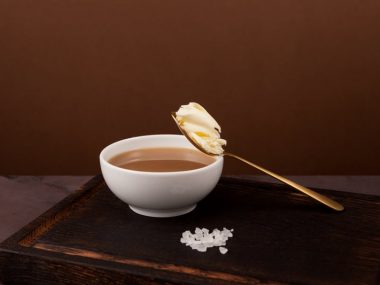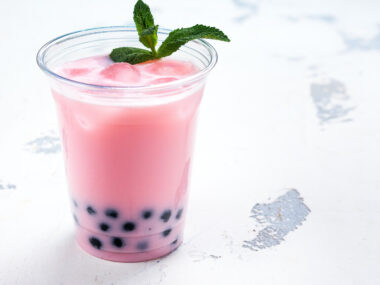That sun tea you’ve been making for years has a very dark side. Before setting that next jar filled with tea bags and water out to steep on the back porch, you’ll want to read this first.
Table of Contents
What Is Sun Tea?
Sun tea is one of summer’s pleasures for many tea drinkers, especially southerners in the U.S. Large glass jars full of water and tea bags are carefully placed outdoors in the direct sun to brew/steep for several hours.
This form of tea brewing is so popular that teaware retailers market large clear sun tea jars and pitchers nearly in every location these days. A sun tea jar typically has an airtight lid to prevent the elements of the outdoors from getting into the tea while outside brewing/steeping.
Sun Tea Dangers
The dark side of sun tea lies within the tea leaves used for loose-leaf tea and tea bags. According to Food Safety News, some bacteria may be present on tea leaves. If a tea is not brewed at hot enough temperatures to kill harmful microbes on tea leaves, tea drinkers become prone to consuming tea that may fall ill.
Sun tea relies on the warmth of the sun to brew the tea within a jar. However, the sun doesn’t get the water hot enough (boiling) to kill bacteria. As such, the jar full of sun tea becomes a vessel of a growing bacteria colony.
What Makes The Best Sun Tea?
For sun brewed tea, typical grocery-store-brand tea bags are usually used. However, for those more discerning tea drinkers, loose-leaf tea is placed into a tea infuser that goes into the water for sun-brewing. Let’s bypass those grocery store shelf teabags and explore other teas used for sun tea brewing.
Please note that because of the potential harm sun tea can cause tea drinkers, we are not recommending or advising our readers to use the sun brewing method. For safety’s sake, the safest brewing method for tea is with hot water.
Teas Used For Sun Tea Brewing
Tea has found its way into various brewing methods. Although the traditional method of brewing tea is with hot water, tea drinkers often opt for other brew methods come summertime.
Cold brewing and sun brewing are a few ways tea drinkers make cold teas. Cold brewing is done by placing tea (loose-leaf or tea bags) into a pitcher of water and allowing it to sit overnight to brew.
Summertime Tea Favorites
Many tea drinkers’ palates tend to lean more towards fruity and floral teas during summer, which is when sun tea brewing is popular. Diehard southerners prefer a robust black tea, whereas health-conscious drinkers like sun brewed tisanes. Earthy tasting and smoky teas usually don’t find their way into a sun tea jar.
Fruity Tea
Fruit-infused teas are summertime favorites. These teas often have bits of fruit to add layers of flavor to black, white, and green teas. A few popular summer teas include:
- White pear
- White peach
- Black tropical
- Lady Grey
Floral Tea
Floral teas often make their appearance come Springtime and continue to be enjoyed throughout summer. Some standalone true teas have beautiful floral nuances without any infusions, while others have flower infusions to give it an inherent floral aroma and flavor. A few of these teas might include:
- Jasmine
- Hibiscus
- Black with rose petals
- Chrysanthemum
- Chamomile
- Lavender
Black Tea
Robust black teas used for sun tea often include those that are standalone without any infusions.
How Long Do You Have To Leave Sun Tea In The Sun?
Knowing how long to brew sun tea comes down to a preference in taste. The longer a tea is brewed, whether hot, cold or in the sun, the stronger the flavor. Most sun tea brewers place their jars of tea out in the hot sun in the mid-afternoon for a few hours at most. This is the opportune time when the sun is at its hottest.
How Warm Does It Have To Be To Make Sun Tea?

Surprisingly, sun tea can be brewed on a cooler day (about 70F degrees) by placing the tea jar in direct sunlight inside a warmer area such as a greenhouse, enclosed patio, or window sill. It will take longer to brew the tea. The downside to sun tea brewing (in addition to bacterial growth) is the sun doesn’t heat the sun tea water; it merely warms it. True brewing is unable to take place—instead, the tea over-steeps.
When using the traditional brewing method with hot water, the water reaches about 165 degrees (F.) Compare that to sun brewing, there’s a significant deficit in degrees of about 60 degrees (F.)
To give you some perspective on the ideal temperature for brewing, a jar of sun tea placed on the ground at the hottest place on earth (Furnace Creek – Death Valley, California) still won’t properly brew your tea. The highest temperature recorded there was only 134 degrees (F.)
Now we are pretty confident you aren’t going to invest precious time trying to come up with a way to brew sun tea under hot enough conditions to prevent bacterial growth. Why not hot brew it on the stove and just add ice?
Why Is My Sun Tea Bitter?
Steeping time with any type of tea is crucial in determining whether or not a tea will be bitter. The longer tea (loose-leaf or teabags) is allowed to sit in water, the more tannins the tea will release. Tannins are responsible for astringency in tea. Some types of tea contain more tannins than others.
A published article by Baylor University Medical Center (Steep your genes in health: drink tea)
explains how tea steeping time greatly affects whether a tea will be overly bitter or not. The article goes on to mention tea (loose-leaf or teabags) steeping should only be a few minutes. The longer the tea remains in the water, the more bitter it grows. Green and black tea that has steeped for 15 minutes is considered so intensely bitter that it becomes more of a medicinal drink.
According to the Journal of Chemical and Pharmaceutical Research, (Determination of tannin content by titrimetric method from different types of tea,) black tea contains the most tannin while green tea has the least amount of tannin. So, when choosing a type of tea to make sun tea, perhaps use this as a guide to selecting a tea lower in tannin.
Based on this evidence, it appears that sun tea is going to be bitter regardless of what tea you use. Some teas, such as black, will be more bitter compared to green tea.
How To Make Sun Tea
We don’t recommend making sun tea because of the dangers that lurk in the jar when it comes to bacteria growth. If you do choose to enjoy this tea, it’s fairly easy to make. Just add your tea (loose-leaf or tea bags) into a jar of water and sit it out in the sun for several hours. Just how many tea bags for a gallon of sun tea will you need? One tea bag is needed for every 8 ounces (1 cup) of water.
Safer and Healthier Sun Tea Alternatives
If you prefer cold, iced tea, we have some suggestions for a safer way to enjoy tea. Cold-brewing tea is trending among tea drinkers, especially those who seek its cold quench for a hot summer day. You aren’t limited to teabags but can explore various types of teas and superb flavors!
There are so many lovely teas that make a wonderful pitcher of cold brew. Teas with fruity flavoring or infusions are perfect. For a more subtle fruity tea, select a white tea. Likewise, for robustness, black tea fits the bill.
Floral/fruity tisanes also make a tasty pitcher of cold-brew tea. Watermelon tea is picking up momentum among tisane lovers. If you haven’t tried it, we wholeheartedly recommend that you do!
Fruity Cold-Brew Recipe
Things You’ll Need:
- Cold-brew tea pitcher with a built-in infuser
Ingredients
- White Peach loose-leaf tea (2 teaspoons)
- Dehydrated or fresh strawberries (3 tablespoons)
- White Peony loose-leaf tea (2 teaspoons)
- Green Melon loose-leaf tea (1 teaspoon)
Directions
- Add all of the ingredients to the tea pitcher infuser.
- Place the infuser down into the pitcher and give the tea a water bath by pouring a little bit of cold water into the infuser to wet down the tea.
- Pull the infuser out and proceed to fill the pitcher with cold water.
- Connect the infuser to the pitcher lid and slowly push it down into the pitcher of water and screw on.
- Place the pitcher into the refrigerator to cold-brew overnight.
No “Sunny” Side To This Tea
There’s just no way to feature sun tea as a safe tea to enjoy because of how quickly a jar of it becomes a petri dish of brooding bacteria. Perhaps it’s time to shift your summer tea-making regime and adopt cold-brewing or hot brewing followed by ice.






